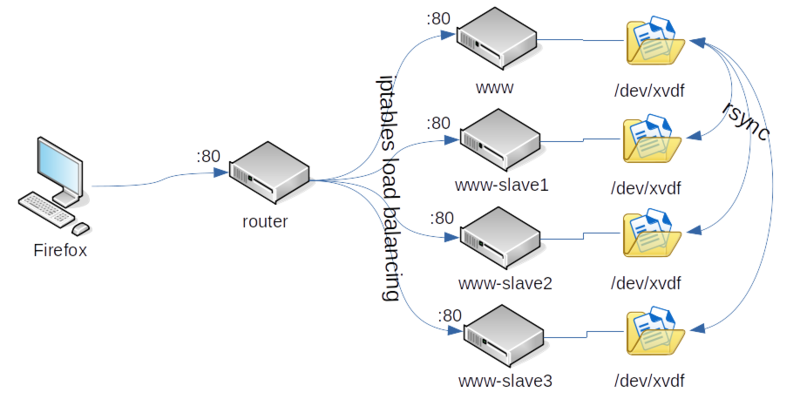OPS345 Assignment 1
Overview
In this assignment you'll use many of the skills you learned so far to set up several Apache web servers with a load balancer.
This assignment assumes that your www.youruserid.ops345.ca is a working web server. If you didn't complete that part of Lab 3: you'll need to do it first.
The format of the assignment is similar to a lab, but it's less specific about the exact steps you need to take. You're expected to show more independent learning abilities for an assignment than for a lab. The extra complicated parts are clarified for you here.
In short, a complete assignment will show that you can:
- Create AMIs from an existing VM and deploy new VMs based on that AMI.
- Use SSH keys, rsync, and cron to keep data on multiple servers synchronized.
- Use iptables as an Apache load balancer by directing traffic to a random slave.
This is the overview of your completed work in the form of a diagram:
Part 1: first slave
- Go to your www VM in the AWS Console and find the button to create an image from it.
- Name the image www-for-asg1-p1
- This will create an AMI with all the software configured the way you configured it.
- Deploy one new VM from the AMI you created above.
- Name it www-slave1
- With primary IP address 10.3.45.21
- In ops345wwsg
- Make sure the second virtual drive is named www-data-slave1
- Add the appropriate iptables rule on router and ops345routersg rule to allow yourself to SSH to www-data-slave1 via port 2221.
- Don't change the hostname of www-data-slave1, leave it as "www".
Sync files with www
Each of your web servers (www and all the slaves) need to have the same data on them. That means you need to synchronize the contents of /var/www/html. You might recall this is mounted from a separate drive (/dev/xvdf) but that doesn't matter for this assignment.
You'll use rsync to do the synchronization, but first you need to set up your user on www-slave1 to be able to ssh to www without a password.
- Create an ssh key on www-slave1 as your regular user. Make sure the key is stored in /home/yourusername/.ssh/id_rsa_wwwsync
- On www edit /home/yourusername/.ssh/authorized_keys
- Paste the contents of /home/yourusername/.ssh/id_rsa_wwwsync.pub from www-slave1 to the end of that file as one line.
- Test your key authentication setup as yourusername on www-slave1 to confirm you can log in to yourusername@10.3.45.11 (www) without a password:
ssh -i /home/yourusername/.ssh/id_rsa_wwwsync yourusername@10.3.45.11
Now set up rsync:
- Create a new file in /var/www/html on www and use this command on www-slave1 to make sure that new file is copied to www-slave1:
rsync -e "ssh -i ~/.ssh/id_rsa_wwwsync" -au --exclude="nextcloud" yourusername@10.3.45.11:/var/www/html/* /var/www/html
- Create a new file in /var/www/html on www-slave1 and use this command on www-slave1 to make sure that new file is copied to www:
rsync -e "ssh -i ~/.ssh/id_rsa_wwwsync" -au --exclude="nextcloud" /var/www/html/* asmith15@10.3.45.11:/var/www/html
- Once you confirm both rsync commands above work: make them run automatically every 5 minutes by editing your user's crontab on www-slave1:
*/5 * * * * rsync -e "ssh -i ~/.ssh/id_rsa_wwwsync" -au --exclude="nextcloud" asmith15@10.3.45.11:/var/www/html/* /var/www/html */5 * * * * rsync -e "ssh -i ~/.ssh/id_rsa_wwwsync" -au --exclude="nextcloud" /var/www/html/* asmith15@10.3.45.11:/var/www/html
- Test that by creating some files on www, some other files on www-slave1, and waiting more than 5 minutes.
